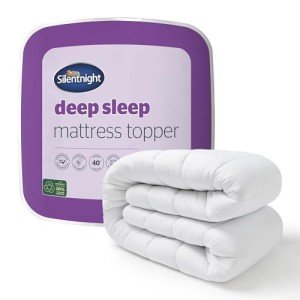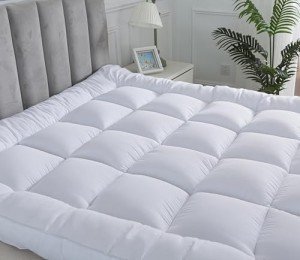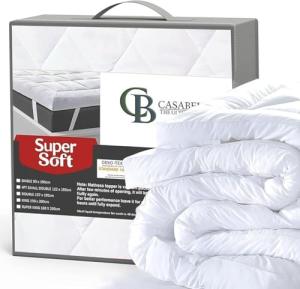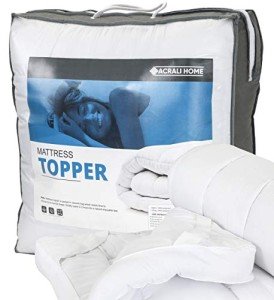The Ultimate Guide to Soft Hypoallergenic Mattress Toppers for Bunk Beds
As families seek optimal comfort in their living spaces, the importance of a good night's sleep cannot be overstated. For families that utilize bunk beds, especially those with children, investing in a soft, hypoallergenic mattress topper can make all the difference. These mattress toppers not only enhance comfort but also offer protective benefits against allergens, facilitating healthier sleep environments. This guide delves into the world of soft hypoallergenic mattress toppers for bunk beds, exploring their types, benefits, and practical considerations for families.
What Is a Mattress Topper?
A mattress topper is an additional layer placed on top of a mattress to enhance its comfort and support. It can be made from a range of materials, including memory foam, latex, down, and fiberfill. For bunk beds, where space is often limited and comfort needs to be prioritized, a mattress topper can significantly improve the sleep experience for children and adults alike.
Why Choose a Hypoallergenic Mattress Topper?
Hypoallergenic mattress toppers are designed to reduce allergic reactions, making them ideal for individuals with sensitivities. Dust mites, mold, and pet dander are common allergens that can thrive within bedding. A hypoallergenic topper can help mitigate these risks, contributing to a healthier sleep environment. Here are some reasons to consider a soft, hypoallergenic mattress topper:
- Reduction of Allergens: These toppers are typically made from materials that resist allergen accumulation.
- Enhanced Comfort: Soft hypoallergenic materials can provide additional cushioning, making sleep more comfortable.
- Improved Sleep Quality: By reducing discomfort and allergens, these toppers can lead to deeper and more restful sleep.
- Protected Investment: A quality mattress topper prolongs the lifespan of your mattress by preventing wear and tear.
Types of Soft Hypoallergenic Mattress Toppers
When selecting a mattress topper for a bunk bed, multiple types are available, each boasting unique features. The key types include:
| Type | Material | Benefits | Ideal For |
|---|---|---|---|
| Memory Foam | Polyurethane foam | Contours to the body, pressure relief | Kids who move during sleep |
| Latex | Natural rubber | Durable, breathable, and eco-friendly | Families seeking sustainability |
| Gel-Infused Foam | Memory foam + gel | Additional cooling properties | Hot sleepers |
| Fiberfill | Synthetic fibers | Soft, lightweight, and easy to clean | Families prioritizing easy maintenance |
| Down Alternative | Synthetic substances | Soft, fluffy feel, and hypoallergenic | Families seeking plush comfort |
Factors to Consider When Choosing a Mattress Topper
Selecting the right mattress topper requires consideration of several factors:
- Thickness: Standard mattress toppers range from 2 to 4 inches thick. Thicker toppers offer more cushioning, while thinner options may provide slight added comfort without overpowering the existing mattress.
- Material: Choose a material that fits your needs—memory foam for support, latex for durability, or fiberfill for softness.
- Cover: A removable and washable cover enhances hygiene, allowing for easy maintenance.
- Breathability: Opt for materials that promote airflow to prevent overheating during sleep.
- Maintenance: Look for toppers that are easy to clean, as bunk beds are often used by children.
Benefits of Soft Hypoallergenic Mattress Toppers
Soft hypoallergenic mattress toppers provide numerous advantages, particularly for children using bunk beds. Some of the most notable benefits include:
- Comfort Enhancement: Soft materials provide a layer of cushioning that enhances the overall sleeping experience.
- Allergen Resistance: A hypoallergenic overlay reduces the risk of reactions from dust mites and other allergens.
- Improved Posture: Quality toppers can provide supportive surfaces that help maintain proper spinal alignment.
- Versatility: Soft hypoallergenic toppers fit seamlessly over many mattress types, from traditional to gel-infused foam.
- Affordability: They are a cost-effective way to prolong the life of existing mattresses and improve sleep quality without the expense of a new mattress.
How to Care for Soft Hypoallergenic Mattress Toppers
Proper maintenance of mattress toppers is essential to ensure their longevity. Here are some care tips:
- Regular Cleaning: Follow the manufacturer's guidelines for cleaning; many have removable covers that can be machine-washed.
- Air Out: Regularly air out the topper to prevent odors and moisture build-up.
- Use a Mattress Protector: A waterproof mattress protector can offer added protection against spills and allergens.
- Rotate Periodically: To prevent uneven wear, rotate the topper regularly.
FAQs about Soft Hypoallergenic Mattress Toppers
1. Can a mattress topper entirely replace a mattress?
- While a mattress topper can enhance comfort, it is not a substitute for a quality mattress. It should be used as an addition to improve sleep quality.
2. Are all mattress toppers hypoallergenic?
- No, not all mattress toppers are hypoallergenic. Look for specific labels or materials known for their hypoallergenic properties.
3. How do I know which thickness is right for my bunk bed?
- Consider the existing mattress thickness, the sleeper's comfort preferences, and the amount of available space between the mattress and the top bunk.
4. Do mattress toppers affect warranties?
- Always check the warranty information on your mattress before adding a topper, as it may void certain terms.
5. Can I wash a mattress topper?
- Most mattress toppers come with removable covers that can be machine-washed, though the interior may have specific cleaning instructions.
Investing in a soft hypoallergenic mattress topper for bunk beds is a simple yet effective way to enhance sleep quality and comfort. By understanding the different types available, considering practicality, and maintaining hygiene, families can create a healthier sleep environment for their children. With the right choice, bunk beds can become not just functional spaces but sanctuaries of restful slumber.






